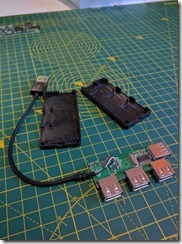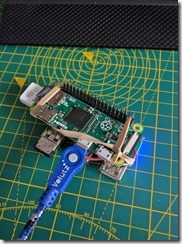Raspberry Pi Zero USB Hub Hack
As much as we all love the Pi Zero, the connectivity options are very limited. With only one (micro) USB port (for peripherals) it means you need a micro <=> ‘normal’ USB adapter to get any of the usual accessories (keyboard, Wi-Fi dongle etc.) plugged in, and when you have that’s it – nothing else can be plugged in. Also, those little USB adapters just look a little bit to precarious for my liking. So, what I needed was a ‘Raspberry Pi Zero USB Hub Hack’.
I’d seen that the USB power and data lines are presented as pads on the board itself. I wasn’t alone in noticing this, and seemingly a bunch of people had success soldering on USB hubs directly. So I though I’d give it a go. I bought myself this little ‘no name’ 4 port USB2 hub from eBay for the princely sum of £2.09 (including delivery) – how they make any profit on these is beyond me.
As soon as it arrived, I pulled the case apart exposing the board itself and cut the USB cable off. (NOTE: I probably should have tested it on the laptop, or Pi first, but I was a bit too eager).
A simple soldering job had the 4 individual cables soldered to their respective pads on the Pi Zero. It wasn’t a great success to start with, as it was ‘hit and miss’ whether it showed up on the Pi after booting.
I guessed that it was likely that not enough power was being delivered, to the hub, by the super thin cables. I decided to remove those completely and replace themwith some thicker cable to make sure there was enough power to the hub. I also used some thicker signal wire for the Data + and –.
However, now it never showed up, not even for a short time.
lsusb
It looked like it was recognising that a hub was plugged in, but it saw it as a ‘new low-speed USB device’. The seller on eBay had advertised this as a high-speed hub, so the ‘low-speed’ was odd. I would also get a lot of device descriptor read/64, error -71 errors in dmesg when the hub did not show up.
dmesg | grep usb
Googling around suggested trying out a bunch of dwc_otg settings in cmdline.txt, but none of those seemed to work. I also switched it to low speed (dwc_otg.speed=1) and that didn’t help. I knew all the connects were good and there were not shorts, so I began to think I had killed the IC on the hub somehow.
A last ditch attempt was to swap around the Data + – wires. I didn’t expect this to work as it was being ‘seen’ by the Pi, just not working. I figured, how could it ‘see’ the hub without being able to read ‘something’ from it. WRONG….
Swapping round the Data + – wires brought it to life, every time I powered on the Pi. Excellent. So now a little tidying things up, getting some anti-static foam between the boards and squishing them together with and elastic band (temporary) got me to the finish line.
lsusb
dmesg | grep usb
Here are some pictures of the finished Raspberry Pi Zero USB Hack project (although it still needs tidying and a case etc.)…
Next up is to replace one of the hub ports with a directly soldered Wi-Fi dongle. Watch this space…
















